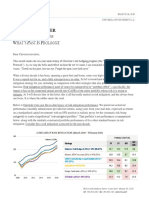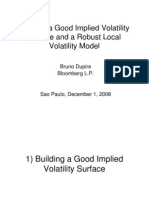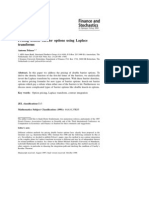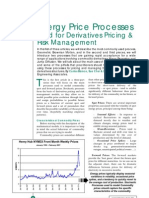Variance Swaps - An Introduction
Uploaded by
Angelo TorresVariance Swaps - An Introduction
Uploaded by
Angelo TorresVariance Swaps: An Introduction
VARIANCE SWAP BASICS
Equity Derivatives
Strategy
April 7, 2005
Marko Kolanovic
(212) 272-1438
mkolanovic@bear.com
Gary Semeraro
(212) 272-4800
gsemeraro@bear.com
A variance swap is an over-the-counter derivative contract in which two parties agree to buy or
sell the realized volatility of an index or single stock on a future datethe swap-expiration
datefor a pre-determined price, the swap-strike. The payoff for an investor who buys variance
using a swap is equal to the difference between the realized and strike variance, multiplied by the
notional amount of the swap: [$ Notional * (Realized Volatility2 Strike Level2)]. An investor who
sells variance would receive the opposite payoff: [$ Notional * (Strike Level2 Realized
Volatility2)]. Variance swap vega is the dollar-change in swap value for each percentage-point
movement in volatility. The vega of the swap equals twice the volatility times the notional amount
of the swap: [2 * Volatility * $ Notional]. Variance swaps have been actively traded over-thecounter for more than 8 years, and more recently (since 2004) have begun to trade on the CBOE.1
Portfolio managers can enter into variance swaps easily. The investor specifies which
underlying index to use and the duration of the swap contract. He then must determine whether
he wants to buy variance (so that he will profit from any increase in the volatility of the index
above the swap strike) or sell it (so that he will profit from any decrease in volatility below the
swap strike). Finally, the investor must decide the type of volatility exposure. Typically,
investors choose vega exposurea $100,000 vega exposure means that the swap value will
change by $100,000 for each percentage point change in the volatility of the underlying index.
Once the investor has an ISDA master agreement in place, he can obtain a quote and trade.
EXAMPLE VARIANCE SWAP AND PAYOFF CALCULATION
Realized volatility is used to determine the swap payoff at maturity. This measure is calculated
from daily index closing prices in a straightforward and standardized way.2
The payoff calculation from an example 30-day short S&P 500 variance swap entered into on
Feb 23, 2005 is shown below. The swap valuation date was April 7, 2005, the notional swap
vega amount was $100,000, and the swap strike price (ask) is 11. The swap settlement value was
9.8701, which was below the swap strike of 11; the contract was closed at a gain of $107,183.
Essentially, as volatility decreased by roughly 1 volatility point, the investor gained $107,183.
Fig. 1: Swap Settlement for 30-Day S&P 500 Variance Swap
2
Day
Trade
1
2
3
4
5
Date
02/23/05
02/24/05
02/25/05
02/28/05
03/01/05
03/02/05
Index Log Return Log Return
1,190.8
--1,200.2
0.7863%
0.0062%
1,211.4
0.9264%
0.0086%
1,203.6 -0.6435%
0.0041%
1,210.4
0.5642%
0.0032%
1,210.1 -0.0273%
0.0000%
.
.
.
.
.
.
.
.
.
23
24
25
26
27
28
29
Valuation
03/29/05
03/30/05
03/31/05
04/01/05
04/04/05
04/05/05
04/06/05
04/07/05
1,165.4
1,181.4
1,180.6
1,172.9
1,176.1
1,181.4
1,184.1
1,191.1
-0.7625%
1.3679%
-0.0694%
-0.6518%
0.2725%
0.4471%
0.2266%
0.5953%
0.0058%
0.0187%
0.0000%
0.0042%
0.0007%
0.0020%
0.0005%
0.0035%
.
.
.
.
.
.
Realized Vol Calculation
Sum of Log Returns Squared
Divided by number of returns (30)
Square Root
Multiplied by square root of 252
Swap settlement value
Swap Payoff
Strike
Vega
Notional
Payoff
0.1160%
0.0039%
0.6218%
9.8701%
9.8701
11
$ 100,000
$
4,545
$ 107,183
Source: Bear Stearns Equity Derivatives Strategy, Bloomberg.
3-month variance futures now trade on the CBOE. The first documented variance swap traded on the FTSE Index in
1993.
2
To calculate this, one first takes the indexs daily log-returns; then the sum of the squares of the returns is divided by the
number of daily-returns measured. This volatility number is multiplied by the square root of 252 to annualize the measure,
and by 100 to return a number in volatility points as opposed to a decimal number. This resulting number is the realized
volatility over the life of the swap, and is the swap settlement value.
Bear Stearns Equity Derivatives Strategy
Page 1
Variance Swaps: An Introduction
The payoff of a volatility swap is directly proportional to realized volatility; the profitability of a
variance swap, however, has a quadratic relationship to realized volatility. These relationships
are shown in Figure 2.
Fig. 2: Payoff of Long Variance and Volatility Swaps Struck at 20 Volatility Points;
$100,000 Notional Vega
$4,000,000
Variance Swap
Volatility Swap
$3,000,000
$2,000,000
Payoff
$1,000,000
$0
10
15
20
25
30
35
40
$(1,000,000)
$(2,000,000)
$(3,000,000)
Realized Volatility (vol. points)
Source: Bear Stearns Equity Derivatives Strategy, Bloomberg.
Since a long variance swap gains more than a simple volatility swap when volatility increases
and loses less than a volatility swap when volatility decreases, variance swap levels are typically
quoted above the expected level of future realized volatility (ie: above option-implied volatility).
This spread between variance and volatility is called convexity. Examples of Bear Stearns
indicative levels for S&P 500 and Nasdaq 100 variance swaps are shown below.3 For example,
on April 7th, an S&P 500 (SPX) variance swap with Dec 05 expiration was bid at 14.4 and
offered at 15.4. A sample term sheet is shown as well.
Fig. 3: Example Quotes for Index Variance Swaps (left); Sample Term Sheet (right)
S&P 500 INDEX VARIANCE SWAP
March 4, 2005
Transaction Summary:
4/7/05
SPX
May'05
Jun'05
Sep'05
Dec'05
Dec'06
FUTURES
Expiry
Expiry
Expiry
Expiry
Expiry
1186 @ 9:46
-- 11.80 / 12.80
-- 12.90 / 13.90
-- 13.80 / 14.80
-- 14.40 / 15.40
-- 15.90 / 16.90
Receives a Payoff at Maturity if the Volatility, as calculated on the Valuation Date, is
greater than the Strike.
Pays a Payoff at Maturity if the Volatility, as calculated on the Valuation Date, is
lower than the Strike.
Seller:
Buyer:
Bear Stearns International, Limited (BSIL)
Trade Date:
March 4, 2005
Valuation Date:
April 15, 2005
Payment Date:
3 Exchange Business Days following the Valuation Date
Volatility Units (USD per point):
USD 100,000
Variance Units (USD per point):
4,385.9649 (Equal to {Volatility Units/ (2*Strike) }
Underlying Index:
S&P 500 Index (SPX)
Strike:
11.4%
4/7/05
FUTURES
Expiry
Expiry
Expiry
Expiry
Expiry
General:
Payoff at Maturity:
NDX
May'05
Jun'05
Sep'05
Dec'05
Dec'06
Buyer enters into a variance swap, under which it
Variance Units * [ (Volatility)2- (Strike)2]
If such amount is a positive number, then Seller shall make a payment to Buyer
1490 @ 9:54
-- 17.00 / 18.00
-- 18.25 / 19.25
-- 19.50 / 20.50
-- 20.25 / 21.25
-- 21.50 / 22.50
If such amount is a negative number, then Buyer shall make a payment equal to the
absolute amount to Seller
Volatility:
252 x
100*
(Re turn( i ))
i =1
, where:
( Indexi )
Return(i) = ln
( Indexi 1)
252 = Annualization Factor
n = Number of observations excluding the initial observation on Trade Date, but including
the Valuation Date
Indexi = The closing level of the Underlying Index i business days from the Trade Date
except for Index0 which shall equal the closing level on the Trade Date and Indexn which
shall equal the special quotation of the Underlying Index on the Valuation Date.
Documentation:
As per ISDA
Currency:
USD
Exchange:
New York Stock Exchange
Market Disruption:
Postponement
Collateral:
Upfront: Subject to portfolio margin calculation agreed upon
Mark-to-Market: As per ISDA
Source: Bear Stearns Equity Derivatives Strategy, Bloomberg.
This historical, real-market example is to be used for illustrative purposes only.
Bear Stearns Equity Derivatives Strategy
Page 2
Variance Swaps: An Introduction
VARIANCE SWAP STRATEGIES
In this section, we list some common applications of variance swaps.
Hedging Equity Returns
Variance swaps are often used for portfolio protection. Index implied volatility (and therefore,
variance) is negatively correlated to equity returns. In addition, the payoff of a long variance
swap increases more rapidly than equity returns decrease. Thus, variance swaps can be used as
crash-protection, insulating a portfolio from very negative equity market performance. Figure 4
shows the relationship between monthly changes in 30-day S&P 500 variance (as measured by
the VIX Index) and monthly changes in the S&P 500 Index.
Fig. 4: Relationship between the S&P 500 and VIX Index; 5 Years of Monthly Returns
120%
R2 = 64%
100%
1M VIX Change (%)
80%
60%
40%
20%
0%
-20%
-20%
-15%
-10%
-5%
0%
5%
10%
15%
20%
-40%
1M S&P 500 Return (%)
Source: Bear Stearns Equity Derivatives Strategy, Bloomberg.
Volatility Relative Value and Directional Strategies
Variance swaps can also be used in volatility-based relative value trades. For example, an
investor can buy S&P 500 variance and sell a similar amount of Nasdaq 100 variance. The trade
will be profitable if NDX volatility decreases relative S&P 500 volatility, or if S&P 500
volatility increases less than Nasdaq 100 volatility. This trade was very profitable in the months
following the tech bubble burst in 2000. During this period, the weight of technology stocks in
the Nasdaq 100 decreased significantly; this ultimately caused Nasdaq 100 Index volatility to
decrease significantly as well, especially relative to S&P 500 Index volatility.
Fig. 5: 3M S&P 500 and Nasdaq 100 Index Volatility; 2000 Present
S&P 500 and Nasdaq 100 3 Months Volatility
100%
90%
Nasdaq 100 3M Volatility
80%
S&P 500 3M Volatility
70%
60%
50%
40%
30%
20%
10%
0%
Sep 00
Aug 01
Jul 02
Jun 03
May 04
Apr 05
Source: Bear Stearns Equity Derivatives Strategy, Bloomberg.
Bear Stearns Equity Derivatives Strategy
Page 3
Variance Swaps: An Introduction
Credit and Equity Volatility Relative Value
A companys credit risk (default risk) is related to its stock price and equity volatility. A decline in
stock price usually leads to an increase in both equity volatility and credit risk (as measured, for
instance, by the price of a credit default swap). The charts below illustrate the correlation between
credit risk (as measured by the spread between BAA-rated US corporate 30-year bonds and the
equivalent treasury rate) and volatility in the S&P 500 Index (as measured by the VIX Index) since
April 2000. The correlation between these two measures was 75% during this period.
Fig. 6: Correlation between Credit Risk (Corporate Spread) and Equity Volatility (VIX)
45
3.5
50
40
VIX
30
2.5
25
2
20
15
10
5
0
Apr-00
1.5
VIX
1
BAA Corporates Spread
R2 = 56%
30
VIX
35
BAA Corporates Spread (%)
40
20
10
0
0.5
Mar-01
Feb-02
Jan-03
Dec-03
Nov-04
1.5
2
2.5
BAA Corporates Spread (%)
3.5
Source: Bear Stearns Equity Derivatives Strategy, Bloomberg.
An investor could use a variance swap to hedge the credit risk of a basket of corporate bonds
because of this relationship. A variance swap could also be used in a credit versus equity volatility
relative value trade. Credit spreads and equity volatility have been positively correlated on the
single-stock level; thus, single-stock variance swaps could be used for company-specific capital
structure trades.
Selling Equity Risk
The implied volatility of the S&P 500 has traded at a persistent premium to realized volatility,
as a result of supply/demand inefficiency; there has consistently been excess demand for putprotection in the S&P 500. An investor can capitalize on this market inefficiency by selling
variance swaps to capture the resulting premium. An investor can create several types of longcash, short-variance portfolios that have S&P 500 variance bonds. An example Notional
Variance Bond is created by lending $100M at the risk-free rate and selling $20,000 notional
variance; an example Vega Variance Bond is created by lending $100M at the risk-free rate
and selling $800,000 notional vega variance. By modifying the amount of variance sold, an
investor can tune the degree of leverage for a given strategy to prevent large losses should the
volatility spike. Historical returns for these strategies are shown in the table below.
Fig. 8: 15-Year Historical Returns of Sample S&P 500 Variance Bonds
Return
S&P 500 Index
9.3%
Notional Var Bond 16.5%
Vega Var Bond
15.7%
Risk Information Ratio
15.1%
0.62
9.0%
1.83
6.6%
2.38
Source: Bear Stearns Equity Derivatives Strategy, Bloomberg.
Bear Stearns Equity Derivatives Strategy
Page 4
Variance Swaps: An Introduction
Disclaimer
This communication is being provided for informational purposes only and is not intended as a
recommendation or an offer or solicitation for the purchase or sale of any security referenced
herein. It is being provided to you by the trading desk referenced above as part of the Firms
proprietary trading activities and on the condition that it will not form the primary basis for any
investment decision. Any views expressed herein are those of the individual author and may
differ from those expressed by other Bear Stearns departments, including any of the Bear
Stearns research departments. The author of this communication may receive compensation
based in part on Bear Stearnss proprietary trading revenues.
Bear Stearns and its affiliates may have positions (long or short), effect transactions or make
markets in securities or options on such securities referenced herein. Bear Stearns may have
underwritten securities for, or otherwise have an investment banking relationship with, issuers
referenced herein. The information contained herein is as of the date referenced and Bear
Stearns does not undertake an obligation to update such information. Bear Stearns has obtained
all market prices, data and other information from sources believed to be reliable although its
accuracy or completeness cannot be guaranteed. Such information is subject to change without
notice. The securities mentioned herein may not be suitable for all investors. Clients should
contact their Bear Stearns representative at the Bear Stearns entity qualified in their home
jurisdiction to place orders or for further information. Bear, Stearns & Co. Inc. is a member of
the NYSE, NASD and SIPC. Copyright 2005 Bear, Stearns & Co. Inc. All rights reserved.
Note: Options strategies are complex and subject to substantial risks and may not be right for
every investor. Individuals should not enter into option transactions until they have read and
understood the basic option disclosure document issued by the options exchanges and the
Options Clearing Corp. Characteristics and Risks of Standardized Options. Past performance
is not indicative of future results. Supporting documentation will be supplied upon request.
Marko Kolanovic
Bear Stearns Equity Derivatives Strategy
mkolanovic@bear.com
Page 5
You might also like
- Stock Market and Mutual Fund and Its ImportanceNo ratings yetStock Market and Mutual Fund and Its Importance77 pages
- Variance Swaps and Volatility DerivativesNo ratings yetVariance Swaps and Volatility Derivatives52 pages
- (Deutsche Bank) Modeling Variance Swap Curves - Theory and ApplicationNo ratings yet(Deutsche Bank) Modeling Variance Swap Curves - Theory and Application68 pages
- BNP Paribas) Corridor Variance Swaps - A Cheaper Way To Buy VolatilityNo ratings yetBNP Paribas) Corridor Variance Swaps - A Cheaper Way To Buy Volatility6 pages
- Inside the Yield Book: The Classic That Created the Science of Bond AnalysisFrom EverandInside the Yield Book: The Classic That Created the Science of Bond Analysis3/5 (1)
- FX Volatility Smile Construction: Dimitri Reiswich Uwe WystupNo ratings yetFX Volatility Smile Construction: Dimitri Reiswich Uwe Wystup12 pages
- Eric Benhamou - Pricing Convexity Adjustment With Wiener Chaos PDFNo ratings yetEric Benhamou - Pricing Convexity Adjustment With Wiener Chaos PDF22 pages
- (Bloomberg, Dupire) Modelling Volatility SkewsNo ratings yet(Bloomberg, Dupire) Modelling Volatility Skews73 pages
- Mele Obayashi 2012 - An Interest Rate Swap Volatility Index and Contract PDFNo ratings yetMele Obayashi 2012 - An Interest Rate Swap Volatility Index and Contract PDF61 pages
- 2008 DB Fixed Income Outlook (12!14!07)No ratings yet2008 DB Fixed Income Outlook (12!14!07)107 pages
- (AXA Investment) Why The Implied Correlation of Dispersion Has To Be Higher Than The Correlation Swap StrikeNo ratings yet(AXA Investment) Why The Implied Correlation of Dispersion Has To Be Higher Than The Correlation Swap Strike4 pages
- Pricing and Hedging of Japan Equity-Linked Power Reverse Dual NoteNo ratings yetPricing and Hedging of Japan Equity-Linked Power Reverse Dual Note59 pages
- Short Volatility Positioning A Cause For Concern BarclaysNo ratings yetShort Volatility Positioning A Cause For Concern Barclays14 pages
- SOFR Derivative Pricing Using A Short Rate ModelNo ratings yetSOFR Derivative Pricing Using A Short Rate Model18 pages
- Dynamics of Interest Rate and Equity VolatilityNo ratings yetDynamics of Interest Rate and Equity Volatility9 pages
- (Columbia University, Derman) Trading Volatility As An Asset ClassNo ratings yet(Columbia University, Derman) Trading Volatility As An Asset Class37 pages
- Lecture 11: Stochastic Volatility Models ContNo ratings yetLecture 11: Stochastic Volatility Models Cont28 pages
- Exotic Interest-Rate Options: Marco MarchioroNo ratings yetExotic Interest-Rate Options: Marco Marchioro66 pages
- Antoon Pelsser - Pricing Double Barrier Options Using Laplace Transforms PDFNo ratings yetAntoon Pelsser - Pricing Double Barrier Options Using Laplace Transforms PDF10 pages
- A Technical Guide For Pricing Interest Rate SwaptionNo ratings yetA Technical Guide For Pricing Interest Rate Swaption11 pages
- Capital Protected Dispersion CertificateNo ratings yetCapital Protected Dispersion Certificate5 pages
- A Simple Multi-Curve Model For Pricing SOFR Futures and Other DerivativesNo ratings yetA Simple Multi-Curve Model For Pricing SOFR Futures and Other Derivatives18 pages
- CLO Liquidity Provision and the Volcker Rule: Implications on the Corporate Bond MarketFrom EverandCLO Liquidity Provision and the Volcker Rule: Implications on the Corporate Bond MarketNo ratings yet
- (Ebook) Interest Rate Markets: A Practical Approach to Fixed Income (Wiley Trading) by Siddhartha Jha ISBN 9780470932209, 9781118017777, 0470932201, 1118017773 - The ebook in PDF format is ready for download100% (1)(Ebook) Interest Rate Markets: A Practical Approach to Fixed Income (Wiley Trading) by Siddhartha Jha ISBN 9780470932209, 9781118017777, 0470932201, 1118017773 - The ebook in PDF format is ready for download36 pages
- Falling Knives Around The World Paper - Brandes InstituteNo ratings yetFalling Knives Around The World Paper - Brandes Institute20 pages
- Problem Set 1 Solutions: Statistics 104 Due February 6, 2020 at 11:59 PMNo ratings yetProblem Set 1 Solutions: Statistics 104 Due February 6, 2020 at 11:59 PM18 pages
- Institutional Design and Liquidity at Stock Exchanges Around The WorldNo ratings yetInstitutional Design and Liquidity at Stock Exchanges Around The World39 pages
- Lognormal Vs Normal Volatilities and Sensitivities in PracticeNo ratings yetLognormal Vs Normal Volatilities and Sensitivities in Practice20 pages
- Ising Model As A Model of Multi-Agent Based Financial MarketNo ratings yetIsing Model As A Model of Multi-Agent Based Financial Market11 pages
- Finance & Risk Analytics: Project ReportNo ratings yetFinance & Risk Analytics: Project Report16 pages
- A Model Combining Lightgbm and Neural Network For High-Frequency Realized Volatility ForecastingNo ratings yetA Model Combining Lightgbm and Neural Network For High-Frequency Realized Volatility Forecasting7 pages
- Journal of Forecasting - 2024 - Lei - Volatility Forecasting For Stock Market inNo ratings yetJournal of Forecasting - 2024 - Lei - Volatility Forecasting For Stock Market in25 pages
- Calculating The VSTOXX Index - VSTOXX Advanced Services 2.0 (August 2014) Docume PDF0% (1)Calculating The VSTOXX Index - VSTOXX Advanced Services 2.0 (August 2014) Docume PDF3 pages
- 2015 Mar 25 Isda Taxonomy v2 0 Eq CR FX Ir Comment Period v4No ratings yet2015 Mar 25 Isda Taxonomy v2 0 Eq CR FX Ir Comment Period v411 pages
- Technical Analysis II - Share Market SchoolNo ratings yetTechnical Analysis II - Share Market School1 page
- Deutsche Bank - Volatility Risk PremiumNo ratings yetDeutsche Bank - Volatility Risk Premium67 pages
- Kaufman 50 Years On, What Have I Learned - V40 - C13 - 397KAUFNo ratings yetKaufman 50 Years On, What Have I Learned - V40 - C13 - 397KAUF12 pages
- (Deutsche Bank) Modeling Variance Swap Curves - Theory and Application(Deutsche Bank) Modeling Variance Swap Curves - Theory and Application
- BNP Paribas) Corridor Variance Swaps - A Cheaper Way To Buy VolatilityBNP Paribas) Corridor Variance Swaps - A Cheaper Way To Buy Volatility
- Inside the Yield Book: The Classic That Created the Science of Bond AnalysisFrom EverandInside the Yield Book: The Classic That Created the Science of Bond Analysis
- FX Volatility Smile Construction: Dimitri Reiswich Uwe WystupFX Volatility Smile Construction: Dimitri Reiswich Uwe Wystup
- Eric Benhamou - Pricing Convexity Adjustment With Wiener Chaos PDFEric Benhamou - Pricing Convexity Adjustment With Wiener Chaos PDF
- Mele Obayashi 2012 - An Interest Rate Swap Volatility Index and Contract PDFMele Obayashi 2012 - An Interest Rate Swap Volatility Index and Contract PDF
- (AXA Investment) Why The Implied Correlation of Dispersion Has To Be Higher Than The Correlation Swap Strike(AXA Investment) Why The Implied Correlation of Dispersion Has To Be Higher Than The Correlation Swap Strike
- Pricing and Hedging of Japan Equity-Linked Power Reverse Dual NotePricing and Hedging of Japan Equity-Linked Power Reverse Dual Note
- Short Volatility Positioning A Cause For Concern BarclaysShort Volatility Positioning A Cause For Concern Barclays
- (Columbia University, Derman) Trading Volatility As An Asset Class(Columbia University, Derman) Trading Volatility As An Asset Class
- Antoon Pelsser - Pricing Double Barrier Options Using Laplace Transforms PDFAntoon Pelsser - Pricing Double Barrier Options Using Laplace Transforms PDF
- A Technical Guide For Pricing Interest Rate SwaptionA Technical Guide For Pricing Interest Rate Swaption
- A Simple Multi-Curve Model For Pricing SOFR Futures and Other DerivativesA Simple Multi-Curve Model For Pricing SOFR Futures and Other Derivatives
- Sectors and Styles: A New Approach to Outperforming the MarketFrom EverandSectors and Styles: A New Approach to Outperforming the Market
- CLO Liquidity Provision and the Volcker Rule: Implications on the Corporate Bond MarketFrom EverandCLO Liquidity Provision and the Volcker Rule: Implications on the Corporate Bond Market
- (Ebook) Interest Rate Markets: A Practical Approach to Fixed Income (Wiley Trading) by Siddhartha Jha ISBN 9780470932209, 9781118017777, 0470932201, 1118017773 - The ebook in PDF format is ready for download(Ebook) Interest Rate Markets: A Practical Approach to Fixed Income (Wiley Trading) by Siddhartha Jha ISBN 9780470932209, 9781118017777, 0470932201, 1118017773 - The ebook in PDF format is ready for download
- Falling Knives Around The World Paper - Brandes InstituteFalling Knives Around The World Paper - Brandes Institute
- Problem Set 1 Solutions: Statistics 104 Due February 6, 2020 at 11:59 PMProblem Set 1 Solutions: Statistics 104 Due February 6, 2020 at 11:59 PM
- Institutional Design and Liquidity at Stock Exchanges Around The WorldInstitutional Design and Liquidity at Stock Exchanges Around The World
- Lognormal Vs Normal Volatilities and Sensitivities in PracticeLognormal Vs Normal Volatilities and Sensitivities in Practice
- Ising Model As A Model of Multi-Agent Based Financial MarketIsing Model As A Model of Multi-Agent Based Financial Market
- A Model Combining Lightgbm and Neural Network For High-Frequency Realized Volatility ForecastingA Model Combining Lightgbm and Neural Network For High-Frequency Realized Volatility Forecasting
- Journal of Forecasting - 2024 - Lei - Volatility Forecasting For Stock Market inJournal of Forecasting - 2024 - Lei - Volatility Forecasting For Stock Market in
- Calculating The VSTOXX Index - VSTOXX Advanced Services 2.0 (August 2014) Docume PDFCalculating The VSTOXX Index - VSTOXX Advanced Services 2.0 (August 2014) Docume PDF
- 2015 Mar 25 Isda Taxonomy v2 0 Eq CR FX Ir Comment Period v42015 Mar 25 Isda Taxonomy v2 0 Eq CR FX Ir Comment Period v4
- Kaufman 50 Years On, What Have I Learned - V40 - C13 - 397KAUFKaufman 50 Years On, What Have I Learned - V40 - C13 - 397KAUF

























































































